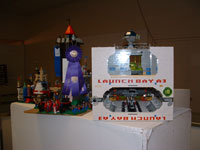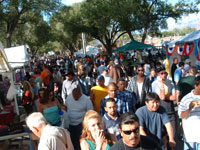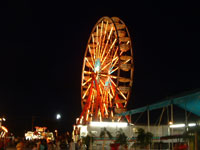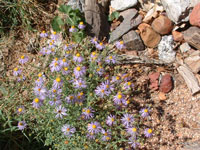A climate-watching friend bids New Mexicans to watch Otis, an east Pacific hurricane running up the cost of Baja on a course that could bring its moisture into New Mexico next week.
1.37 inches of rain at my house, a bit northeast of the University of New Mexico. The National Weather Service is reporting 1.19 since it started raining late yesterday afternoon.

Sadie is so busted. From the front page of this morning's Albuquerque Journal (paid sub. req.):
The one improvement in her life, her owner says, is that she recently figured out how to open kitchen cabinets to get at the trash can.
It was in the newspaper. It must be true.
This is apparently not Bart Simpson's web site:
Just as a print of your fingerprints, palms, soles, and ears tell a story, so does your rump. The lines, crevices, and folds of your fanny.... can, to the trained eye, reveal your personality, fate, and future in luck and love.
Apparently all you need to do is send a close-up picture of your ass, along with a not insubstantial sum of money for a personal reading.
In its richest manifestations, real life is truly funnier than The Onion.
On the size of the Balloon Fiesta crowd: "There's just no way that many people are attending the fiesta."
Last night I raised the question: Is there anything Google can't do?
Yes.
Years ago, at a seminar on investigative journalism, a veteran reporter suggested that the most underrated tool for digging out information is the phone book. Everyone's in there, more or less. For years I took that to heart. But lately Google has proven much more valuable for the same sort of thing.
But in my recuperation from knee surgery, I've needed a book of a certain heft. It has to be the right height to stand on, stepping up and down over and over to strengthen my quad.
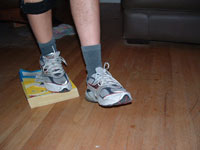
Google can't do that.
music: Paper Tiger, the Felonious Groove Foundation. I am so tragically unhip that it was only recently that I grasped my own fondness for the funk. Plus, you've gotta love an album dedicated to Malcolm Gladwell and John Denver.
book: Just finished Lee's Ferry: A Crossing on the Colorado, by Evelyn Brack Measeles. How to say this politely.... There are many times when I'm taken aback reading, thinking, "I wish I'd written that." This was not one of those occasions. But it did give a good overview of the basic facts of John D. Lee's establishment of the river crossing, with some fun stuff about the intersection of Lee's and John Wesley Powell's paths in 1872, when Powell was preparing for his second run through the Grand Canyon.
books: Been playing with Google Print, their digitized library project. There's clearly no way to read a book this way, but it seems a potentially useful research tool. Is there anything Google can't do? (Well, yes. More on this later.)
science: For a story I've been working on at work, yesterday I read the famous 1935 Einstein-Podolsky-Rosen paper. I am not a physicist, so it's not easy going. But, equations aside, the paper's central point is made with remarkable clarity. But there was this moment when I read one of the key paragraphs, and looked up at the author's name. Einstein wrote this. Shivers. From his brain to mine. Insanely cool.
I've been reading about Lee's Ferry, and puzzling over the different ways to refer to it. It's the spot on the Colorado River just downstream from Glen Canyon Dam that today is the put-in for Grand Canyon river trips. It used to be the only reasonable river crossing for hundreds of miles in either direction, a ferry crossing set up by old John D. Lee back in the 1870s. It also is marks the line between upper and lower basin states for the purpose of division of Colorado River water.
My confusion: on maps and in books it's alternatively "Lee's Ferry" or "Lees Ferry" or "Lee Ferry." Found an answer of sorts this weekend in "A Crossing on the Colorado: Lee's Ferry" by Evelyn Brack Measeles:
The name was officially declared to be Lees Feery (no apostrophe) in the Sixth Report of the United States Geographic Board.** Rusho, W.L. "Living History at Lees Ferry," Journal of the West, Vol. VII, No. 1, Jan. 1968
So it's officially "Lees Ferry," but Measeles doesn't like it. "His has always been the pervading presence," she writes, "no matter how many other people touched it." So she give's it the posessive. I agree.
We've been pretty fixated as a community here in Albuquerque for the last month on the trope of "John Hyde, evil cop killer." (For those of you outside Albuquerque, Hyde is a schizophrenic man chaged with shooting two cops and three other people over the course of Aug. 18.) That's why Leann Holt's story in this morning's Journal is so powerful (I'm really sorry to say you've got to pay for this. What are those idiots at the Journal thinking?)
Leann shares the wrenching, tragic story of Hyde's family as he went through a downward spiral and they desperately tried to get help. It's a part of the story that's incredibly important, and had not been told. Money quote:
"As long as we can dehumanize the mentally ill, we never have to deal with it," Bauman said. "Until we own them as members of our society, nothing will change."
I followed Johnny_Mango's trail of blogcrumbs on yesterday morning's bike ride up Second Street by the old rail yard south of downtown to see the cars for the new RailRunner commuter trains. Sweet,
FYI, this is not me:
Religion and art — A June 19 Opinion article said performance artist John Fleck received taxpayer money for a piece featuring a toilet with a picture of Jesus on its lid. The National Endowment for the Arts denied Fleck funding in 1990, and the Supreme Court upheld its decision in 1998.
I'm working on a quantum physics story at work, which means a great deal of procrastination, as anyone who's tried to write about quantum stuff for a lay audience can I'm sure understand. My latest way to waste some time while creating the illusion of doing useful work: Climate Change in the West.
In fine lazyweb tradition, several alert and helpful readers pointed me to Six Degrees of Wikipedia, a tool that finds the shortest path within Wikipedia linking one idea to another.
Here's my test: Global warming->1750->September 30->Hoover Dam->Colorado River Compact.
(Note that you seem to need to enter the precise URL string from the Wikipedia entry, i.e. "Kevin_Bacon".)
The urban wetland that Mark and I have been so lovingly documenting (see also here and see here for a satellite picture) is about to disappear.
The big machines were out this morning beginning their anual scooping of the dirt, cleaning it out to bare concrete. As a journalist by both inclination and profession, I can of course make the argument for the other side in this: the boys at the flood control authority have a mandate to prepare the city for a 100-year-flood, so they have an engineering design specification for the channel's capacity. The dirt that piles up at the bottom, enabling the lovely wetland, reduces that capacity.
But that knowledge made the plaintive cries of three killdeer this morning, standing helplessly on the concrete bank as their home was bulldozed, no less heartbreaking.
Daughter Nora suggests what I think is a fabulous idea.
Someone needs to do a Kevin Bacon-style analysis of the linkages within Wikipedia as a body of knowledge: how many links separating any two given ideas within Wikipedia? And what sort of idea/knowledge clusters emerge?
David Appell's calling it quits. He's the guy who first got me interested in climate blogging. A terrific blog, and I'm sad to see it go.
A thoughtful reader points out, in regard to last night's post about climate variability in the Colorado River basin, that I didn't make what I will call the Pielke Jr. point: "the problem is not the climate change but the societal changes!" (That's quoting my thoughtful reader (TR), not Pielke.)
TR is of course right. It's not climate variability per se that is the problem here. The problem is twofold. First, it's a problem that the folks who set up the system for allocation of Colorado River water didn't understand the extremes of variability that could affect the river's supplies. The second is that population and associated human systems have grown up around the Colorado River's water with no clear understanding of the variability in water availability that is inevitable in the long run. We are, as a result, extremely vulnerable to the sort of severe, sustained drought that tree ring records suggest has happend in the not-so-distant past. We're not vulnerable in the same way as the Anasazi. We son't starve. But there could be significant societal dislocations.
One thing worth doing in this context is is to examine the difference between the hunter-gatherers who inhabited the Four Corners region before the puebloans, as compared to the Anasazi. Hunter-gatherers survived droughts worse than the ones that coincide with the end of the Anasazi culture. The short answer for why is that the hunter-gatherers had apparently read Pielke, and therefore did not max out the resources, leaving them the flexibility to respond to drought when it happened. In other words, they reduced their societal vulnerability to climate variability.
The Anasazi did not read Pielke, and died.
This is Delph Carpenter, speaking Nov. 12, 1922, ad the twelfth meeting of the Colorado River Commission:
The hydrographers and experts advise me that a twenty-year record on a river is adequate in its completeness and includes enough years to warrant an assumption that the average there deduced would be the average flow of the river in the future.
How wrong he was.
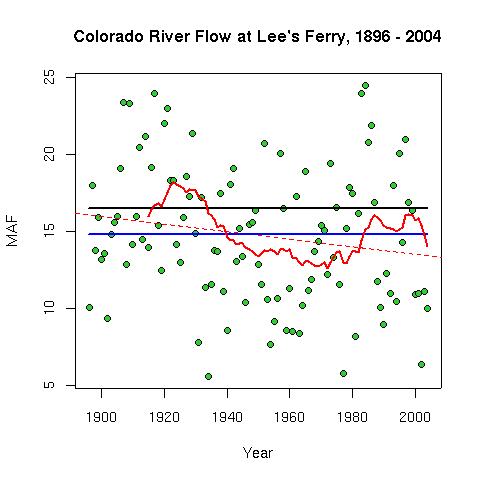
The green dots represent the Colorado River's flow at Lee's Ferry (adjusted to represent the flow if the river would have been undammed). The black line is the amount the commission assumed based on the available river data - about 20 years' worth. The blue line is the actual long-term average since 1896. And the red jiggly line is the rolling 20-year average, positioned at the end of the 20 year interval. You can see it's highest in the early 1920s - at about the time the commission was meeting in Santa Fe. (data from the Upper Colorado River Commission)
Carpenter and the other commissioners thought that a sufficiently long period - perhaps ten years, but certainly twenty - should be sufficient to average out the ups and downs of long-term climate cycles in the west. You can see they were quite wrong.
I've not been terribly diligent of late at updating my NukeBeat blog, so I made a post last week asking who was reading it and why. I was thinking of junking it, but I got a lot of response, so I decided to keep it. And use it as a test bed for a WordPress upgrade. New tech is always fun.
It's like losing a friend (sub. req.):
Rowland Nurseries Inc., whose slogan is "life should be beautiful," is calling it quits after 52 years in business.Owners cited increased competition and skyrocketing prices for shipping and freight as reasons for the closure.
It marks the end of one of the state's largest and longest running family-owned nursery businesses. The late Pat and Reba Rowland opened a single location in 1953, and it has since grown to encompass five Albuquerque stores, a distribution business and a wholesale plant operation.
"It has definitely been a wonderful ride with this community," said president Michael Rowland, who grew up in his parents' business.
Rowland's is simply part of our lives.
As readers of this blog know, I love my garden - the ebbs and flows of the seasons, the endless surprises, its slightly untamed nature. Rowland's has always been a part of it, full of ideas and a sense of the possibility of urban nature. We bought plants there, and garden gear, but most importantly we went there for ideas, a sort of combination art gallery and art supply store for the urban natural canvas - a sweet and eclectic place that seemed to instinctively understand my needs.
Rowland's can't compete with the combination of rising transport costs and big box retailers. Albuquerque gardening will not be the same.
From Mikaela, some fascinating data on U.S. farms:
# 15% of the farms in the U.S. produce 90% of agricultural output.
# These 15% are farms with sales over $100,000.
# 78% of all farms in the U.S. have sales less than $10,000.
# Of these farms, the average farm income is -$4,000.
# Big farms and small farms are both growing in number.
# More people are farming because they like the lifestyle and working second or third jobs to support their farming habits!
Of some relevance to the current discussions about development impact fees in Albuquerque, from Josh Akers in this morning's Journal (sub. req.):
Developers could be paying more to build in Rio Rancho by the end of the year.
Rio Rancho city councilors are considering a proposal to increase impact fees charged to developers by 62 percent by January 2008.
The council had its first look at the proposal Wednesday night.
The proposal is the result of more than two years of work with two different consultants to figure out what developers should be paying for streets, parks, public safety, water and other infrastructure needs.
Developers currently pay $6,094 in impact fees to build a single family home.
Under the proposal a developer would pay $9,882 in impact fees by January 2008.
"It is a very important process and with all the growth we are having there is a large number of dollars coming from impact fees," Palenick said. "This is a draft, a recommendation. We will listen to legitimate input and the number could change."
My tribe, doing what it does:
My colleagues who are down here are warriors. There are a half-dozen of us living in a small house on a side street Uptown. Everyone else has been cleared out.We have a generator and water and military C-rations and Doritos and smokes and booze. After deadline, the call goes out: "Anyone for some warm brown liquor?" and we sit on the porch in the very, very still of the night and we try to laugh.
Some of these guys lost their houses -- everything in them. But they're here, telling our city's story.
And they stink. We all stink. We stink together.
book: "Water and the West," by Norris Hundley, a history of the development of the Colorado River Compact. I'm trying to understand who understood what, and when, about the nature of drought and its implications in the arid southwest. (The answers may be "no one" and "never," which would help explain the fix we seem to be in.)
more reading: Global Water Resources: Vulnerability from Climate Change and Population Growth, from Science, July 2000. Its point is that, much like the discussions of hurricanes and climate change of late, it's growing human population, not global warming, that is the driving variable in understanding the potential future impacts of drought.
music: The Bonnie Raitt Collection. I've got this riff to write about Bonnie Raitt and Casablanca, and the nature of carefully executed craft. (It's one of those blog items I've thought through enough times on bike rides or while driving to work that I'm always amazed that I've never written it down.) Suffice it to say that I can always return to this album or that movie and never be disappointed. And if I were not happily married, I might chuck it all and follow Ms. Raitt from town to town, listening to her music and hoping against all hope to bump into her in the hotel lobby.
the bike: There is a simple pleasure in washing down the bikes.
code: It's never as simple as I think. I've run up against the IE/Win Unscrollable Content Bug. Must .... test .... more .... browsers....
The equinox is 10 days hence, but this afternoon it felt as if things were most aligned.
As I was doing the dishes, a shaft of light from the setting sun shot through the back door, over the kitchen sink and into the pantry, illuminating for a brief but shining moment a jar of Solana Gold organic applesauce.
It was the return of Househenge.
So the Sahel, where people really die when drought happens, could be wetter in a globally warmed world, according to new research by a team led by Reindert J. Haarsma of the Royal Netherlands Meteorological Institute:
We hypothesize that through this mechanism greenhouse warming will cause an increase in Sahel rainfall, because the warming is expected to be more prominent over the summer continents than over the oceans. This has been confirmed using an ensemble of 62 coupled model runs forced with a business as usual scenario. The ensemble mean increase in Sahel rainfall between 1980 and 2080 is about 1–2 mm day−1 (25–50 percent) during July–September, thereby strongly reducing the probability of prolonged droughts.
Published in GRL Sept. 10.
It was with some happy surprise that I realized this evening, when looking at search string refers in the Inklogs, that this blog is in the Google top 10 when one searches on both cheap shit and weird shit.
I think we've got a new corporate slogan here: "Inkstain. Serving up weird cheap shit since, like, 1999 or something."
Feedback in the Aug. 20 New Scientist ruminates on the exhibit at the Yokohama Museum of Eurasian Cultures that included CAT scans of mummified animals. It ponders the "doubly truthful" statement: "This is a cat scan," and offers the neologism "diontologia" to describe such utterances. "Are there," the author wonders, "any triontologias?"
I'm not sure if this counts, but when I was going to college in Walla Walla, Wash., many years ago there was a French restaurant downtown called The Left Bank. Its name was an obvious reference to the Seine's Left Bank. But, as you faced it, the restaurant also was to the left of a bank. In addition, there was an old creek that flowed through the center of town - Mill Creek - that passed to the right of the bank. It was in a concrete channel, and largely covered, but still one could reasonably argue that the restaurant was on Mill Creek's left bank. I argued that the Left Bank restaurant was a living triple pun. Could one also argue that it was a triontologia?
This, in a nutshell, is why I love the New Mexico State Fair:
It's Launch Bay A3, one of the many Lego creations on display in the arts and crafts building. It's an amazing labor of love and creativity with full symmetry as befits the zero gravity of space, where there is no up and down.
That's the sort of thing you see at the fair, where everyone brings their passions together into one spot - the hiphop kids dancing and rapping, the Aloha Elvis made of beads, the Statue of Liberty also made of beads (with painted fingernails and toenails), the giant vegetables, the prize-winning cactus. I mean, where else will you see a tricked out low-rider bicycle being ridden by a carved wooden Day of the Dead skeleton? It's the humanity....
Lissa and I went last night and wandered a while. We didn't see everything yet. The fair now, for us, requires at least two visits. But we did manage to stay past dark so we could see the midway in lights.
The asters are in bloom:
That's in our backyard. I saw a bunch out along the bosque trail this morning while out riding. If any of you know more about the natural history of our New Mexico version(s) of this plant, drop me a line. I only know 'em as "asters," but this is an enormous family. There seem to be at least three found in and around Bernalillo County.
I've been helping my sister-in-law set up a web site, using free templates from Erisfree (hat tip luis). It's my first real look inside a bottom-up CSS web design, and I love it! I've always funked around with tables nested within tables and other truly awful HTML hacks, and never really grokked CSS. Used properly, it's sweet. I've been thinking about an Inkstain redesign, and this might give me a fun geek excuse.
I've always puzzled over one of economists' central claim of markets - the idea that the market, in its chaotic efficiency, has already taken account all the available information in setting the current price for the commodity at hand.
It always seemed naively obvious to me that there must have been someone who got there first with the information, before the market reflected it, and made a killing. The question really seemed to be - how do we get to be the one who gets there first?
I was reminded of this today by James Annan's economist joke:
Two economists are walking down the road, and one says to the other "Hey, do you see that? It looks like a 10 pound note in the gutter over there. I'm going over to get it". The second replies "Don't bother, if it really was a tenner someone would already have picked it up".
The joke is in the midst of a nice post worth reading, the summation of which is that markets are not necessarily good predictors of the future (say, the price of oil in 2010 or something), but rather are good collectors of the best available current information about what the future might hold.
These are my people:
Times Picayune Reporter FoundStaff at the New Orleans Times Picayune received a shot of good news this afternoon, when editor Jim Amoss talked to missing Times Picayune reporter Leslie Williams for the first time since the reporter went missing on Thursday while covering Katrina along Mississippi's Gulf Coast.
"This is best news I've heard in days," Mr. Amoss said by phone Sept. 5. "He was covering the story from Mississippi under hellacious conditions. He was on assignment and we're just now hearing from him, we haven't had a chance to debrief him yet."
more on missing journalists
While I'm doing New Mexico nature writing, let's consider the creosote.
A friend at work asked me this afternoon why creosote survived in Isleta, the pueblo south of Albuquerque, which my friend rightly thought was far north of its natural range.
As it happens, I had a paper on my desk that offers a bit of an answer.
Creosote is a spindly desert shrub that has always been dear to my heart. It's the dominant species on the landscapes of the big deserts of southeastern California, where we used to camp winters when I was a kid. They arrange themselves spatially with a sort of rhythm that dominates the landscape.
My friend was right. Isleta, up around 5,000 feet in elevation (1600 meters) is pretty much at the top of their range, and they're a very recent arrival. Farther south, packrat middens at the Sevilleta National Wildlife Refuge, north of Socorro, show they've been in residence for something like 2,500 years. But up the road at Isleta, they're a more recent arrival, maybe less than 200 years.
Why? In part, us. To quote from the Duran et al. paper:
Rangeland overgrazing resulting from high stocking rates of cattle, sheep and horses in the late 19th century coupled with extended drought periods have created conditions conducive to desert shrub invasions into formerly grassland habitats.
Creasote bush - Larrea tridentata - is one of the first species to move in, followed by cactus (Opuntia) and Yucca.
Two fun bird sighting in the last few days.
Sunday, a flock of bushtits blew through. David Sibley describes them as "a disheveled-looking, long-tailed ball of fluff," and I think that's apt. There were eight of them at one point all perched on the stalk and leaf stems of a single sunflower in our front yard, picking off the aphids.
This morning, I pulled up the bike along the flood control channel after hearing the cry - Sibley uses the words "agitated" and "strident" to describe it, which is also apt - of killdeer. I had to look hard to find them, wading ankle-deep in the water on the channel's bottom. I love the way the flood control channel is an accidental bit of nature, in between the rusty busted shopping carts and other urban detritus.
Three or four years ago, I heard a talk by Roger Pielke Jr. at an American Meteorological Society meeting that changed the way I think about the relationship between climate and human societies. It was about hurricanes, and he talked about Hurricane Mitch, which killed something in excess of 10,000 people in Central America - perhaps as many, by some counts, as 20,000. Roger's simple point, as I remember it, was that the dominant variable in the equation leading to that death toll was the fact that the people in Central America were sufficiently poor that they lacked the resources to not die.
At the time, I had been rather naively thinking that the threat of more powerful hurricanes as a result of global warming was a good argument in favor of reducing greenhouse emissions. Roger's talk convinced me that reducing societal vulnerability to the storms that will happen, warming or not, is a far more effective approach to helping people not die in hurricanes. I've since come to realize that, while there are good reasons to reduce greenhouse gas emissions, reducing societal vulnerabilities in a range of areas, from droughts to floods, is a far more important issue in coping with climate variability and change, both natural and human-caused.
I can't begin to keep up at this point with the important issues being raised by this discussion, but clearly Katrina offers an opportunity to crystallize this sort of thinking. Roger's got a blog now, and has a lot to say. Go read it.
Shrubs.
When it gets warmer in the arctic, you get more of 'em. In turn, they absorb more sunlight, creating a positive warming feedback. The paper's by Matthew Sturm of the Army's Cold Regions
Research and Engineering Laboratory-Alaska, being published tomorrow in the first issue of the new JGR-Biogeosciences.
I rode my bike up Tramway Sunday, the first real hill I've climbed since since April, since I started feeling the cartilage in my knee falling apart.
Last time I climbed Tramway - a big sweeping five miles up a long alluvial fan into the foothills of the Sandias - was with a group of teammates, and my knee ached but we were having fun. And then the next Thursday, Jaime and I did a bunch of steep climbs in the foothills, and on the last one I cracked, my knee hurt so bad I had to stop. I looked up the hill, got back on and finished it that morning, up to the base of the tramway that gave the climb its name. Then there was MRI-surgery-crutches-figuring out how to walk again. My summer of self-pity.
There are few greater joys than ridin' your bike with a bunch of friends. After we hit the top of the long Tramway hill Sunday, on the rolling boulevard back through town, Steve said, "C'mon, let's catch Jaime." Jaime was way ahead, but Steve patiently led me out, slowly accelerating while I sat on his wheel, always glancing back to make sure he wasn't leading me out too fast.
Wth the help of the stoplight at Montgomery, we caught Jaime. And my knee did not hurt.
For grins, an analysis of web traffic over the last 11 months on Inkstain:
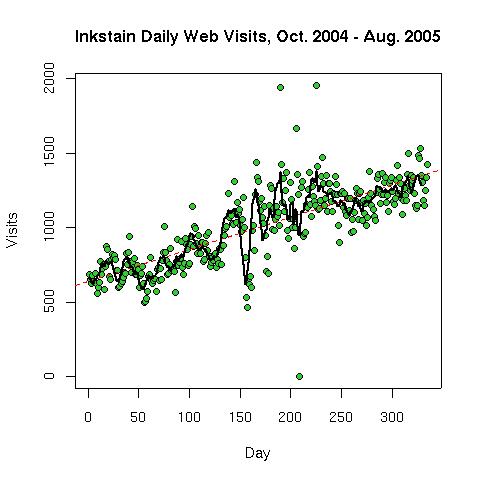
Green dots are daily "visits," as defined by Webalizer's default - essentially all requests from the same IP address separated by less than 30 minutes count as a single "visit." (This means that people poking Inkstain for its RSS feed more frequently than every 30 minutes, like p.g.o does, show up as a small number of visits despite accounting for a large number of hits.)
The black line is a 7-day rolling average, and the red dotted line is a simple linear regression - not really statistically meaningful, but hey - this is a blog, not science!
I'm looking for some reasonable way of sorting out how many of the hits/visits are coming from bots. If one assumes they're well-behaved and are therefore asking for "robots.txt," then they account for something like 10 percent at most. But I've got to think it's substantially higher than that.
I am happy to report that "Mozilla/5.0 (X11; U; Linux i686; en-US; rv:1.7.10) Gecko/2005" is the most common browser here, suggesting that despite my increasingly tenuous connection to the free software world as anything other than a user, the prototypical Inkstain readers are still geeks with too much time on their hands. And that perennial favorite, "Google games," remains the most common search string by which people find their way here.
(Stats done with R.)
I ushered in autumn this morning out in the cool early morning air of Moriarty, sitting along State Route 41. Across the way, a tractor and a center-pivot irrigation rig (alfalfa?) sat silent. The little planes from the Moriarty airport droned overhead. And that characteristic "thunkthunk" of time trial bikes with disk wheels kept rolling by.
The Record Challenge is one of north-central New Mexico's little treasures, a tiny Labor Day weekend event rich with tradition. There are people who come from all over the country to ride it, and for good reason: the stretch of road from Moriarty to Estancia and back is the flattest, straightest, fastest 40 kilometer time trial course in the country. Lots of national records have been set here, including the fastest men's and women's 40 k's ever ridden in this country, plus nearly every age group record.
I couldn't ride this year, but ended up about 100 yards up from the finish line with a camp chair and a two-way radio calling out riders' numbers as they rolled by in that painful tunnel that is the finishing stretch of a 40 k time trial.
Three new national records over the two days of racing, the most impressive being Bill Meyers, whose 26:58.57 Sunday broke his own 65+ 20K. And then, for good measure, he came out Monday and did the 40 k in 56:18.03. As Bill McLain pointed out, "The guy is 68 years old!" Ah, to grow old so gracefully.
Roger Pielke Jr. on the utter failure of the federal government to be prepared to respond to Katrina:
The question that needs to be asked, and it is not too soon to begin asking, is why was the federal government so unprepared for the disaster in the face of robust scientific knowledge about the disaster at all time scales? This is especially in light of the fact that the government completely reorganized itself after 9/11 to improve the nation's preparedness and response to catastrophes.
This amused me:
It's a Tikimon "hand-activated spinner". You push down on the top bit and the little guy in the middle with the stickey-out tongue spins around. It was the toy included with a Carl's Junior child's meal.
Welcome to all those who found Inkstain after searching on "chrome moulding and jaguar" and "power barge sturgis".
Heidi Snell has some good photos posted of last Saturday's state time trial championships.
